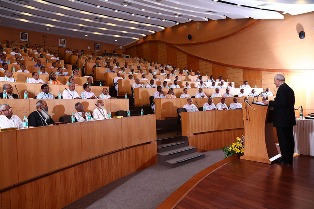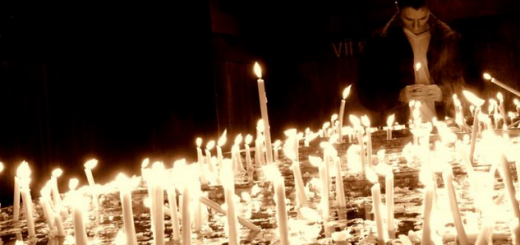American cardinal’s discovery of India

Published on: 8:36 am, April 8, 2016 Story By: Mark Zimmermann – Matters India
Cardinal Donald William Wuerl addressed the March 2-9 biennial plenary of the Catholic Bishops’ Conference of India in his first visit to the country. The American prelate spoke on the topic “Pope Francis, Church Renewal and the New Evangelization.”
The cardinal, who is the archbishop of Washington, traveled to India from Feb. 26 to March 2. He responded to interview questions from Mark Zimmermann, editor of the Catholic Standard, about what he witnessed about the Catholic Church there. Excerpts:
Was this your first trip to India? How did this come about?
Cardinal Donald William Wuerl: This visit to India, my first, was to address a joint gathering of the Conference of Catholic Bishops of India (Latin Rite) and the bishops of the Synod (Conference) of the Syro-Malankara Church and the bishops of the Synod (Conference) of the bishops of Syro-Malabar Church in India. Every two years, all of these bishops, approximately 200, gather for a Plenary Assembly under the title of the Catholic Bishops’ Conference of India. The head of all three of these conferences, respectively Cardinal Oswald Gracias of Bombay Cardinal George Alencherry, Major Archbishop of Ernakulam-Angamaly of the Syro-Malabar Church, and Cardinal Baselios Cleemis, Major Archbishop of Trivandrum of the Syro-Malankara Church, collectively invited me to come and speak to the theme: Pope Francis, Church Renewal and the New Evangelization. For me it was a privileged moment to be with so many bishops responsible for the Catholic Church and its many manifestations in great subcontinent of India.”
What were your impressions of the Catholic Church in India? What did you find most inspiring about the faithful in India during your visit there?
From the moment of my arrival in Bombay on through the time in Kerala and concluding with the visit to Bangalore, I came away with the impression of a very vibrant Church with strong focus on its young members. For example, I spoke at the seminaries in Bombay and Kerala and found them to be, because of the number of students, a focal point of hope for the future. In both Trivandrum, Kerala and in Bangalore, I had opportunities to meet with large numbers of university students, all very much engaged in the life of the Church. On two occasions I spent a Holy Hour with university students (several hundred) who regularly come together to pray, to support one another and to have time before the Blessed Sacrament. At the same time, I have to note that the Church and many Catholics in India suffer from a resurgent anti-Christianity that impacts on the Church’s ability to carry out her mission. For example, during my visit much of the discussion was around a recent Supreme Court ruling in India that Christians may not seek converts to the faith.”
In Bombay, you visited a seminary and spoke with faculty and students, and at Trivandrum, you had lunch with the Daughters of Mary and later dinner with priests at a campus. From your interactions with the seminarians, priests and religious, what impressed you about how they are seeking and living out their vocations?
It was particularly impressive to see the number of seminarians and young people who are entering religious life. My time at the Mother House of the Daughters of Mary was a joyful moment of seeing so many young sisters, novices and postulants all at the service of the Lord. In the courtyard of the Mother House was a banner that read “We Are Pure and Poor for the Lord.” I think it speaks of the clear focus of religious life in India.”
In your speech to the bishops in Bangalore, you referred to Blessed Teresa of Calcutta’s witness of charity. During your visit, did you get to see any of her Missionaries of Charity and their work?
Particularly in Kerala but also in Bombay and certainly in Calcutta that I did not have the opportunity to visit, the presence of the Missionaries of Charity is significant. It was as I was preparing to leave that we learned of the four Missionaries of Charity who were executed in Yemen by the Islamic State militants.”
In that same speech, you spoke about the importance of the New Evangelization, for Catholics to deepen and renew their faith and share it with others boldly and with joy. Later after you returned to Washington, you noted that Christians in India are by law restricted from welcoming converts to the faith. How then can evangelization occur in that land?
One of the unique aspects of the Church in India is its educational and social service ministries. While direct conversion may not be allowed by law, the Indian populous embrace the Church for the great ministries of education and healthcare that the Church in India offers and has offered for many, many years. Sometimes evangelization is as much by our witness and care as it is by our words and proclamation. In fact, in speaking with the bishops I reminded them that very often they are the living example of what Pope Paul said many years ago: “Modern man listens more willingly to witnesses than to teachers, and, if he does listen to teachers, it is because they are witnesses” (Evangelii nuntiandi, 41).
What can Catholics and Christians in our country learn from the experience of how the faithful in India are enduring such legal restrictions in living their faith – is that a warning to us, and a call to solidarity?
We can never take for granted our religious freedom and the ability to carry out our ministries. One of the reasons why this archdiocese together with the Little Sisters of the Poor and so many other churches, healthcare institutions, Catholic Charities, and universities are in federal court is precisely to protest the decision of this Administration in our country to claim the right to determine what is Church ministry. That is only the first step in a gradual erosion of our basic first freedom, religious liberty.”
Of course, the birth of the Catholic Church in India dates to apostolic times, and the evangelizing missions of St. Thomas. Considering that legacy and what you witnessed, do you have hope that the Christian faith in India will continue to flower?
In a number of my presentations, including the homily at the Cathedral in Bombay, the talk to some of the students at the School of Engineering, and of course to the bishops themselves in the Plenary Session, was the reference to the antiquity of the Catholic faith in India. The place of the Church cannot be dismissed since it goes back nearly 2,000 years to Saint Thomas the Apostle and then renewed, once again, in the 16th century by Saint Francis Xavier.”
A highlight of your pastoral work in the Archdiocese of Washington is visiting Catholic communities at our college campuses, and during your visit to India, you met and prayed with youth at an engineering college in Trivandrum. What inspired you about that experience?
The enthusiasm of the students in the engineering college in Trivandrum and the seriousness of their questions left a great impression upon me. These were joyful, happy and engaged college students who at the same time had a great reverence for their faith and the desire to grow more deeply in it. We are also seeing in our own country something parallel to that. I find on many of our campuses, in our Catholic campus ministry programs and particularly at The Catholic University of America campus, a renewed energy and commitment to the faith among many, many young people. Perhaps this is in response to the failure of the secular culture to provide really enduring and profoundly satisfying responses to the great questions of the human heart in every generation. Young people at some point begin to ask, “How shall I live? What are the norms by which I will guide my life? What is the purpose and meaning of life?” To all of these responses, Jesus offers us the truth about ourselves, our lives and the goal of life.”
Each May, the Asian and Pacific Catholic communities, including Catholics from India, have a pilgrimage to the Basilica of the National Shrine of the Immaculate Conception. After your visit to India, what have you learned about the living faith of Catholics from that country, and what can other Catholics learn from them?
As you know, each year whenever it has been possible, I celebrate Mass for the great gathering of the Asian and Pacific Catholic communities including Catholics from India who come together at the Basilica of the National Shrine of the Immaculate Conception. The stories of the faith of all those wonderful people have always permeated that gathering but this time I will be able to share something of my own experience of my visit to India, however brief, with the participants at the Mass. One of the points I made in speaking with the gathering of priests was the presence in the consciousness in India across all religious lines of two extraordinary figures: Mahatma Gandhi and Teresa of Calcutta. One brought focus and attention to the political and social order of India, the other brought a spirituality and commitment to the poor that has become a frame of reference for religious expression across India.”
In your address to the bishops in India, you spoke about Pope Francis and his encouraging of Catholics to go out and encounter others, meet them where they are and bring them Christ’s Gospel. Do you see that spirit of Pope Francis unfolding in India, and if so, how?
Clearly Pope Francis has captured the imagination of people in India as he does everywhere. It was evident to me that all of those bishops at the Plenary Assembly were very much caught up in Pope Francis’ challenge that we go out, that we encounter people where they are and that we accompany them on life’s journey. They recognize that the going out for them, many times, takes the form of service, missions and ministry, and that the meeting of people is in the dialogues and efforts of mutual understanding. But all of this is the beginning of an accompaniment that with God’s grace can bear great fruit for the Church.”
Were there any particular personal experiences that you would like to share?
At the conclusion of the visit to Bangalore the night before I was to leave, Cardinal Cleemis, who was just that day reelected President of the Conference, hosted a dinner for a number of priests and bishops in which the theme was my 50th anniversary of priestly ordination. This provided occasion for a number of priests to speak about the importance of priestly ministry and also an opportunity to encourage the younger priests to continue to invite other young men to consider priestly ministry.
Another beautiful moment for me was the opportunity to visit the work underway for the home for retired priests in Trivandrum, Kerala. This archdiocese, through its mission efforts, is a significant contributor to this project. There are two buildings in this small compound, one is for children who are HIV positive born from mothers with that condition and the second is a home for the older priests who are no longer able to continue ministering in parishes. Both buildings are testimonies to the Church in India – its great care for those with great need and its willingness to stand with both the young and sick and the elderly and needy.”
(This interview first appeared in Catholic Standard on April 7, 2016.)
















